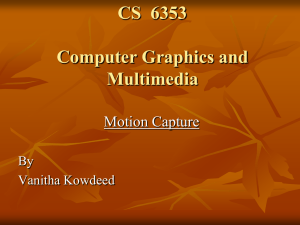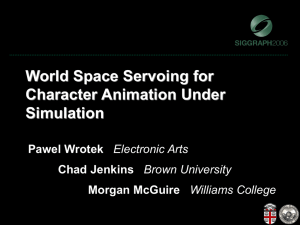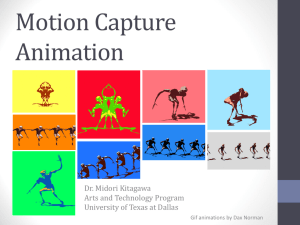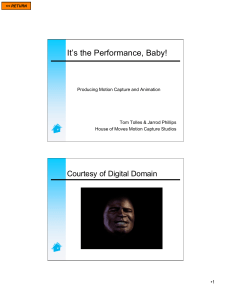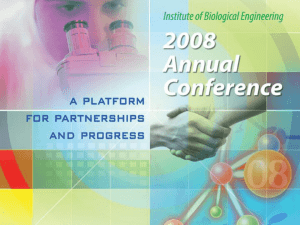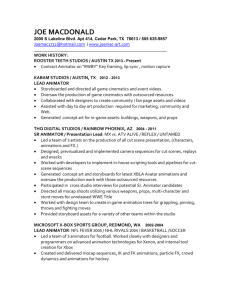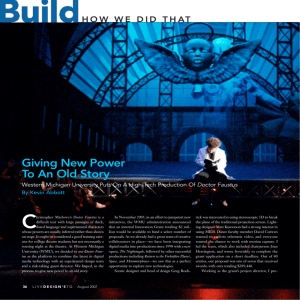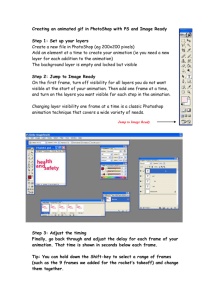Lecture Slides - UBC Computer Science Undergraduate Homepage
advertisement
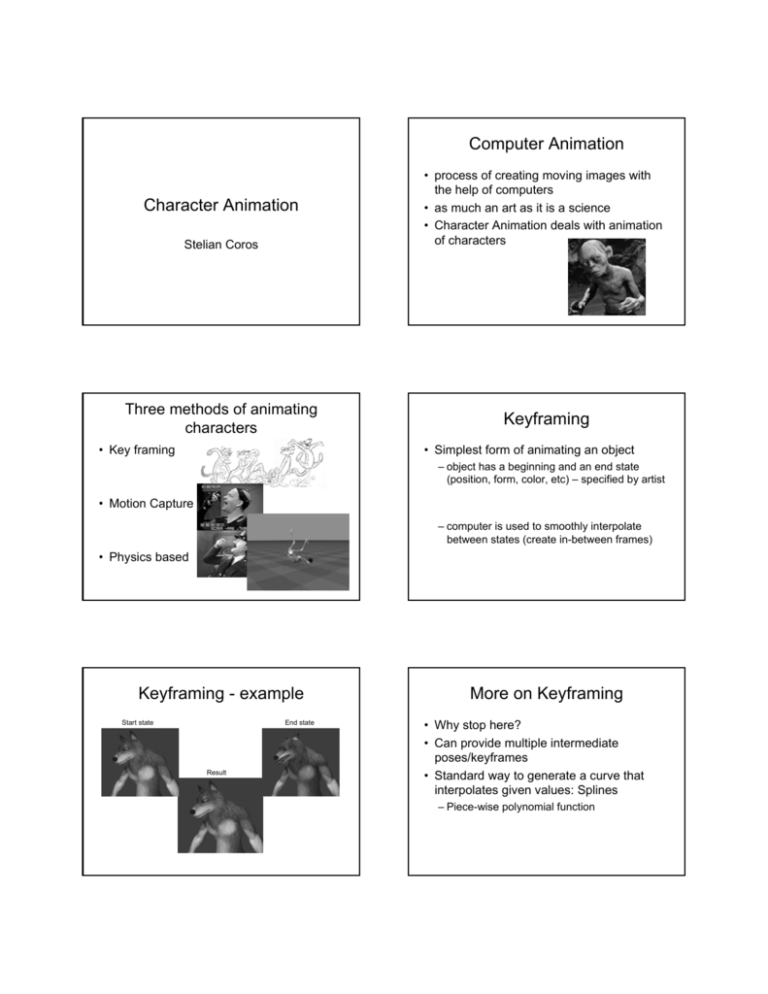
Computer Animation Character Animation Stelian Coros Three methods of animating characters • Key framing • process of creating moving images with the help of computers • as much an art as it is a science • Character Animation deals with animation of characters Keyframing • Simplest form of animating an object – object has a beginning and an end state (position, form, color, etc) – specified by artist • Motion Capture – computer is used to smoothly interpolate between states (create in-between frames) • Physics based Keyframing - example Start state End state Result More on Keyframing • Why stop here? • Can provide multiple intermediate poses/keyframes • Standard way to generate a curve that interpolates given values: Splines – Piece-wise polynomial function Splines Control point Interpolation vs. Approximation polynomials At control points, we must enforce constraints: - polynomial values must match – continuity (C0) - maybe also the same first, second,... derivatives (C1, 2 C , ...) Linear vs. Higher order interpolation Interpolation Curve goes through control points Approximation Curve goes near control points Splines • Many, many different choices – Hermite splines, catmull-rom, B-splines, Bezier curves, etc. • Choice depends on the application, but some curves are better than others – Local vs Global control Linear interpolation not smooth enough – leads to robotic movements Cubic splines almost always used for motion curves Keyframing in Flash • Flash provides a “tweening” capability – short for “in-betweeing” • Tutorial: http://www.echoecho.com/flashtweenings.ht m • How does adjusting one control point affect the curve Keyframing - recap • Requires artists to create keyframes (important poses) • Computers used to create in-between frames (replaces interns/assistant animators) • Videos... Motion Capture (mocap) • Main idea: hire actor to play desired motions, record them so that they can be played back Skeletons and mocap • To describe a character pose, we need root position/orientation and joint angles for each joint in the skeleton • Record all this data for each frame Skeletons • Mocap usually operates on skeletons (aka articulated figures) • Skeleton: hierarchical tree structure made up of links/bones and joints But how does it work? • Actor wears a special suit with markers on it (markers can emit light, reflect light, etc) • Track position of each marker using multiple cameras (6-24), at as much as 200Hz – no need to interpolate between frames But how does it work? Mocap • More processing can be used to obtain joint angles for skeleton • Store joint angles – data driven animation • Large databases of mocap sequences are available – Carnegie Mellon University’s motion capture library for example (http://mocap.cs.cmu.edu/) • Video... Extending Mocap • Playing individual mocap sequences is easy, but not good enough for interactive applications • Need to combine multiple mocap sequences: Motion Graphs (L. Kovar, M. Gleicher , F. Pighin - SIGGRAPH ’02) Motion Graphs Edges represent valid transitions Nodes represent mocap sequences Interpolation/blending may be needed between different mocap sequences Video... Extending Mocap • Creating new motions: “Pushing people around” (O. Arikan, D. A. Forsyth, J. F. O'Brien - SCA’05) • Collect motions of real people responding to pushes • Modify existing motions to respond to different kinds of pushes (direction/location) • Video... Mocap – the bad • It requires specialized studio, hardware, etc. • Can only be used for some kinds of creatures • Only suitable for motions that are anatomically/physically (no superhero martial arts) possible. • If conditions (e.g. terrain) change, mocap data might become inappropriate Mocap – the good • Very useful tool – used a lot in games, movies, etc. • Produces smoother, more natural results than keyframing • Needs less effort to obtain results • Can be used to create new motions Physics Based Simulation Physics Based Character Animation • Let the laws of physics dictate how the characters should move – ragdolls • Can potentially eliminate many drawbacks from mocap-based methods – virtual actors Physics Based Character Animation • Simulating the physics of articulated bodies is relatively easy – Euler-Newton equations, Featherstone’s ABM, Lagrangian Dynamics, etc. • Many hard problems: Physics Based Character Animation • Draws upon the fields of Computer Graphics, Biomechanics, Computational Dynamics, Artificial Intelligence, Machine Learning, Robotics, etc Physics Based Character Animation • Some recent success: Simbicon (K. Yin, K. Loken, and M. van de Panne, SIGGRAPH ‘07) • Video... – character control – maintaining balance – repertoire of skills – learning from MOCAP Simbicon A few last words... • Control strategy: Finite State Machine + PD control Desired link position Spring and damper • Every method has pros and cons • Combining the three methods is very powerful • State of the Art in Industry – Dynamic Motion Synthesis: Natural Motion, Endorphin • Video... Current link position Thank you! Any Questions?
